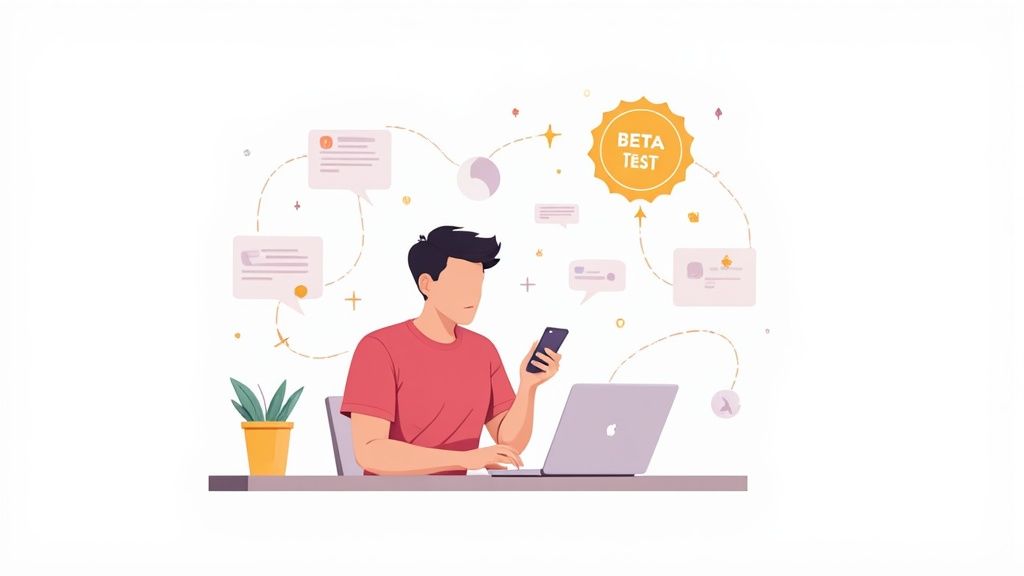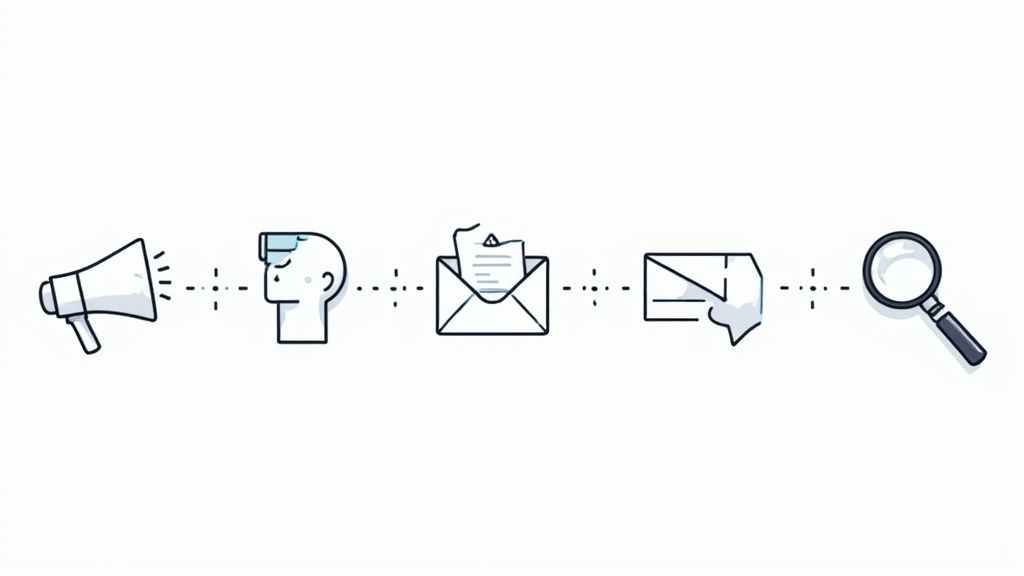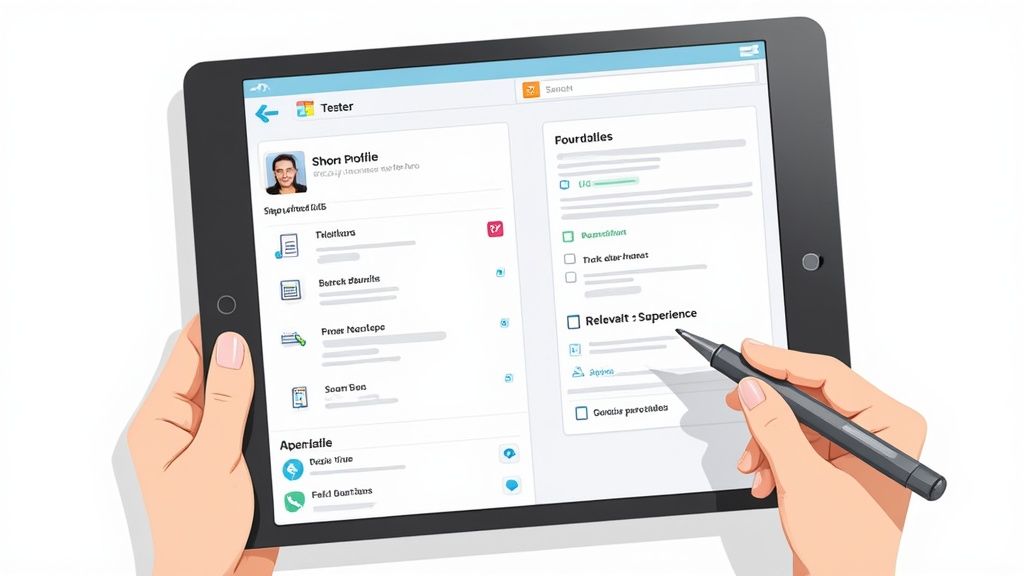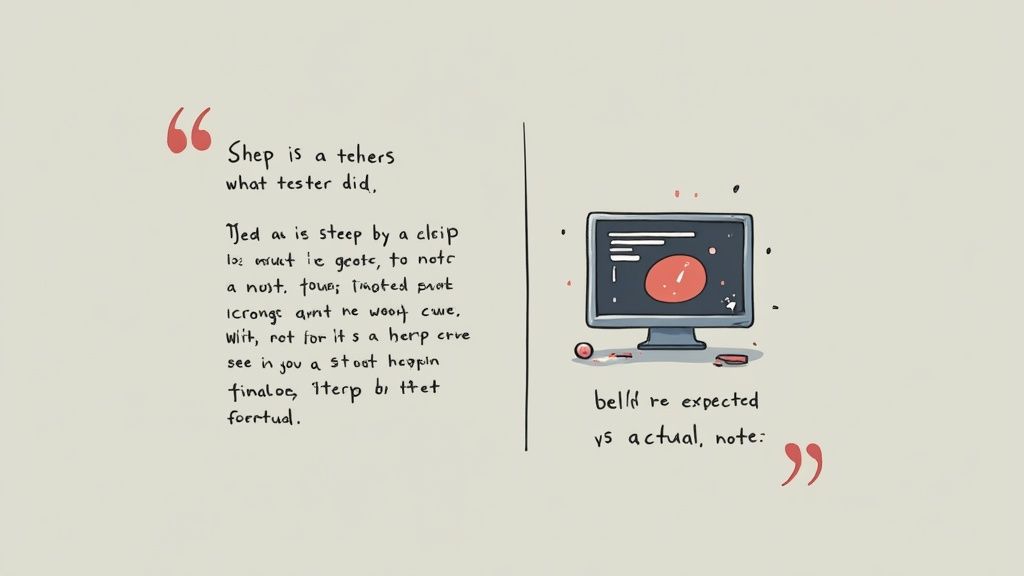How Do You Become a Beta Tester

So, you’ve thought about getting your hands on the latest apps and software before anyone else. The real question is, how do you actually become a beta tester? It all boils down to finding the right programs, showing them what you bring to the table (like your devices and interests), and then giving them feedback that actually helps.
This isn't just about early access; it's your chance to help shape the products you might end up using every day.
What It Really Means to Be a Beta Tester

Being a beta tester is like getting a backstage pass to the world of tech. You get to try out new products before they hit the market. And no, you don't have to be a coding genius. Companies are actually looking for regular people to find bugs, point out confusing features, and just share what it feels like to use their product.
Honestly, your perspective is what they’re after. Developers can get tunnel vision—they're just too close to the project to spot the simple things that might drive a new user crazy. You’re the fresh pair of eyes that can catch a problem before it frustrates thousands of real customers.
Why People Jump Into Beta Testing
What gets people into testing? It’s more than just a sneak peek. Many testers are passionate about the products they use and genuinely want to make them better. For others, the perks are a pretty big draw.
- Paid Gigs: Yep, many companies will pay you for your time and thoughtful feedback.
- Sweet Rewards: You could snag free products, gift cards, or some cool company swag.
- Beef Up Your Resume: It's a fantastic way to learn how software gets made and add some unique experience to your profile.
- Join an Inner Circle: You become part of a select group that has a genuine say in how a product turns out.
To give you a clearer picture, here’s a quick breakdown of what the role typically involves.
Beta Tester Role At a Glance
| Essential Trait | Typical Task | Potential Reward |
|---|---|---|
| Attention to detail | Hunting for bugs and glitches | Monetary compensation |
| Clear communication | Writing detailed feedback reports | Free products or software |
| Curiosity | Exploring every feature | Exclusive access and swag |
| Reliability | Meeting testing deadlines | Career skill development |
Ultimately, being a beta tester means you're stepping into the shoes of a future customer to ensure the product is ready for its big debut.
Beta testing has been around for a while, starting when companies realized they needed to see how their products held up in the real world before a big launch. By 2025, most testing happens on platforms that connect testers directly with companies hunting for specific feedback. You can find some cool history on how beta testing has evolved over at Headspin.io.
A beta tester's true job is to be a professional user—curious, thorough, and honest. You are the final quality check before a product meets the world.
Where to Find Legitimate Beta Testing Gigs

Alright, you're set up and ready to go. So, where do you actually find these testing opportunities? The internet is a big place, and knowing where to look is half the battle if you want to avoid scams and find projects that genuinely need your help.
Your best bet when starting out is probably a crowdtesting platform. Think of them as the middlemen who connect companies needing feedback with testers like us. They take care of all the boring stuff—logistics, payments, project management—so you can just focus on testing.
Popular Crowdtesting Platforms
You've probably heard of the big names: UserTesting, BetaTesting.com, and Testbirds are solid, well-established players in this space. They consistently have projects from all kinds of companies, from tiny startups to massive tech corporations. Signing up is free, but you’ll need to fill out your profile in detail to get matched with the right kind of gigs.
My two cents? Don't just stick to one platform. Get yourself set up on a few. This way, you open yourself up to way more opportunities that match your specific devices and interests.
The market for this is blowing up, by the way. In 2023, beta testing software was already a $1.2 billion market. By 2032, it's projected to more than double to $2.5 billion. What does that mean for you? More gigs, more variety, and more companies realizing they need testers to get things right. You can dig into the expanding market for beta testing on Dataintelo.com if you're curious about the numbers.
Beyond the Usual Platforms
While the big platforms are a great foundation, they're not the only game in town. Sometimes the best opportunities are found by looking in less obvious places.
- Social Media & Newsletters: Seriously, just follow the companies and developers you like on X (formerly Twitter) or sign up for their email lists. It's often the very first place they'll announce a new beta program.
- Dedicated Communities: Dive into Discord servers or Telegram channels. If you're into gaming, software, or especially Web3, these communities are where the magic happens. Early-stage projects are always in there looking for their first batch of users.
- Web3 Questing Platforms: If you're focused on the crypto and blockchain world, you need to be on platforms like Domino. They structure beta tests as "quests" for new dApps and features. In fact, you can go explore active Web3 quests right now and see what's happening.
By tapping into these different sources, you can build a steady flow of interesting projects and never run out of things to test.
How to Create an Application That Gets You Picked

Finding a cool beta program is one thing, but actually getting picked is a whole different ballgame. Your application is your first—and often only—shot to convince a project manager you're the right person for the job. This isn't just about filling in fields; it’s about selling yourself.
Think of it as your tester resume. You have to remember, these project managers are drowning in applications. They're looking for specific signals that show you’re observant, can communicate clearly, and, most importantly, fit the user profile they’re targeting. A generic, slapped-together application is a fast track to the "no" pile.
Showcasing Your Value as a Tester
Your application needs to practically jump off the screen and say, "I'm the one you're looking for!" The secret to doing that is getting specific. Really specific.
Don't just say you have a "smartphone." Tell them you have an iPhone 15 Pro running iOS 17.5 or a Samsung Galaxy S24 on Android 14. To a developer trying to squash a device-specific bug, these details are pure gold.
But it goes beyond just your hardware. You need to connect your real-life experience to their product.
- Relevant Hobbies: Applying to test a new fitness dApp? Mention you’re a marathon runner who’s obsessed with tracking stats on Strava.
- Work Experience: If it’s a new project management tool, make it clear you live in Asana or Trello every day at your job.
- Tech Skills: Even mentioning that you’ve built a simple no-code landing page before shows you’re not a complete beginner and have an eye for user experience.
Your whole goal is to connect the dots for the person reading your application. Don't make them guess. Show them exactly why your life makes you the perfect person to break their product.
In 2025, projects are obsessed with finding testers who fit very narrow profiles. With 35-50% of beta testing happening on mobile, your device specs have never been more critical. They use this data to make sure the app doesn't crash on the exact phone their ideal customer is using. For a deeper dive, check out some of the insights on G2's beta testing leaders.
Finally, take your time with any open-ended screening questions. This is your chance to show you can do more than just click buttons. Be clear, be thoughtful, and prove you can give them the kind of detailed feedback that actually helps, not just a lazy "it's broken."
Giving Feedback That Actually Makes a Difference

Alright, you got accepted. High five! But now the real work starts. Your feedback is the whole reason you're here, and the quality of your insights is what separates the legendary testers from the ones who get ignored. This is how you build a killer reputation.
Trust me, vague comments like "it crashed" or "I don't like this button" are completely useless to a development team. They have no idea what to do with that. Your report will likely get pushed to the bottom of the pile, and you’ll have wasted a chance to actually improve the product.
The best feedback is structured, detailed, and clear. Think of yourself as a detective laying out the clues for the dev team to solve the case.
Crafting the Perfect Bug Report
Your most powerful tool as a tester is a rock-solid bug report. It's not just about pointing out what broke; it’s about giving the developers a step-by-step recipe to recreate the exact problem themselves.
Here’s a simple formula I always use to make my reports super actionable:
- What I Did: Lay out the exact sequence of clicks and actions. For example, "I tapped on my profile icon, then navigated to the settings menu, and finally, I hit the 'Change Avatar' button."
- What I Expected to Happen: Briefly explain the outcome you were anticipating. "I expected a new screen to open up, letting me upload a profile picture from my phone's gallery."
- What Actually Happened: Describe the result in detail. "Instead, the app froze for about three seconds and then crashed, sending me back to my phone's home screen."
Want to become a developer's favorite person? Include a screenshot with some circles or arrows drawn on it, or even better, a quick screen recording. Visuals cut through the noise and eliminate all the guesswork. It's the gold standard.
Differentiating Bug Reports from Usability Feedback
Not all feedback is about broken code. Sometimes, a feature works exactly as designed, but it just feels clunky, confusing, or awkward to use. This is usability feedback, and it’s just as critical as finding bugs.
A bug is when the code breaks. Poor usability is when the experience breaks. Report both, but frame them differently.
Let's say you're testing a new gamified to-do list app. A bug is when checking off a task crashes the whole thing. Usability feedback, on the other hand, might be suggesting that the points you get for completing a task are too low to feel rewarding. (If you're curious about how those game-like elements actually work, this piece on a gamified task manager is a great read).
If you’re testing dApps with social features, it also helps to have some context on how platforms handle user-generated content. Knowing a bit about different content moderation services can help you give much sharper feedback on things like safety and community interaction features.
When you can provide both technical bug reports and thoughtful experiential feedback, you prove you're an invaluable part of the team. You're helping shape a product that doesn’t just work, but one that people will actually love to use.
Becoming a Go-To Tester Companies Rely On
Getting into a single beta test is a great start, but let's be real—the ultimate goal is to become that tester companies keep on speed dial. You want to be the person they invite back for the next project, and the one after that. This is how you move from casual testing to more exclusive—and often paid—gigs.
So, how do you do it? It's simple, really: be the kind of tester you’d want to hire. That means being responsive, hitting your feedback deadlines without needing a reminder, and actually showing up in the community Discord or forum. A little active participation goes a long way.
Turning Experience Into Opportunity
Every test you wrap up is another notch on your belt. Don't just finish it and forget it. That experience is your currency, and you need to put it to work for you. Think of it as building your professional toolkit.
Here’s how to make that experience count:
- Spruce up your LinkedIn: Add "Beta Tester" or "QA Feedback Specialist" to your profile. Be specific about what you’ve tested, like "Web3 gaming dApps" or "DeFi protocols."
- Update your resume: Create a section for "Projects" or "Volunteer Experience." This is where you can mention the number of critical bugs you found or point to a specific usability suggestion that the team actually implemented.
- Create a simple portfolio: For bigger projects you're proud of, write a quick case study. A few paragraphs explaining the product, your testing approach, and how your feedback made a difference is all you need.
Here's a pro tip: Treat every beta test like an interview for the next one. Project managers absolutely remember the testers who provide thoughtful, well-documented feedback. They'll always check with their trusted circle of testers before posting a new opportunity publicly.
When you bring this level of professionalism to the table, you're doing more than just helping a team build a better product. You're building a reputation that opens doors to paid QA roles and makes you a respected voice in the space. This is how you become a beta tester that companies can’t afford to lose.
Got Questions About Beta Testing?
Getting started as a beta tester, you're bound to have questions. It’s totally normal to wonder what you need, what you'll earn, and what the day-to-day actually looks like. Let's tackle some of the most common ones so you can jump in with both feet.
Lots of newcomers think they aren't "techie" enough to give good feedback. Let's bust that myth right now.
Do I Need to Be a Coder to Be a Beta Tester?
Honestly? Almost never. While a handful of super-niche projects might want someone with a specific technical background, the vast majority of companies are looking for feedback from people just like you. They need to see how their product lands with a real user, not another engineer.
What you really need is a keen eye for detail, the ability to explain your thoughts clearly, and a knack for following directions. If you can describe why a button felt awkward to use or point out the exact moment an app crashed, you've got the most important skills covered.
What’s the Pay Like for Beta Testing?
The pay can be all over the place, so it's good to know what to expect. Some gigs, especially for brand-new indie projects or open-source tools, might be unpaid. The reward there is getting a sneak peek and helping shape a product you're excited about.
When it comes to paid tests, you could see anything from $10 for a quick 15-minute task to over $100 for more involved studies that take up a few hours. The pay usually depends on how complex the product is and if they need testers who fit a very specific profile. It's a fantastic way to make some extra cash on the side, but don't plan on quitting your day job.
I always tell people to think of it as a fun, rewarding side hustle. You get paid to play with new tech and your feedback genuinely makes it better for everyone else.
What's the Real Difference Between Alpha and Beta Testing?
Great question. This one trips people up, but it's pretty simple once you see where they fit in the development timeline. They're just two different steps in the quality control process.
- Alpha Testing: This is the early, "internal" phase. The company's own team (developers, QA staff) bangs on the product. It’s often buggy, might be missing features, and is definitely not ready for the public.
- Beta Testing: This is where you come in! The product is now stable enough to be tested by an external group. The goal here is to catch those last few sneaky bugs and get solid feedback on the overall experience before it goes live.
What Kind of Gear Do I Need?
You probably already have everything you need to get started. A smartphone (either iOS or Android) and a computer (Windows or Mac) are the usual suspects.
Companies are always crystal clear about the requirements. They'll tell you if you need a specific version of an operating system, a webcam for a video interview, or a microphone to record your thoughts. When you set up your profile on testing platforms, just be thorough and list all the devices you have access to—it's the easiest way to get matched with more testing opportunities.
Ready to land your first Web3 testing gig? Domino is the perfect place to find and jump into quests from some of the coolest projects out there. Explore active campaigns and start earning rewards today.
Level Up Your dApps
Start using Domino in minutes. Use automations created by the others or build your own.
